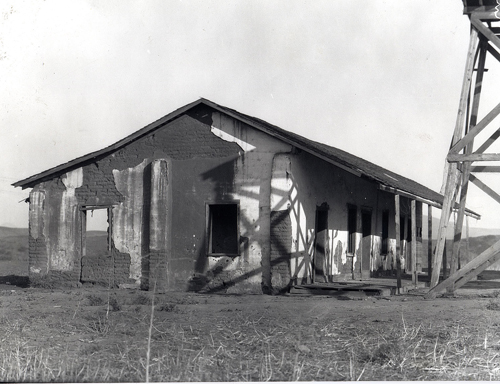|
Juan María Osuna Adobe
Submitted by the Rancho Santa Fe Historic Preservation Committee
Located in the historic Rancho Santa Fe Covenant, the first Juan María Osuna adobe is one of the oldest in California. Built during the early 1830s and situated in the heart of Rancho Santa Fe on a knoll overlooking the San Dieguito River Valley, the adobe stands as a historic link and exemplar of California's political, military, and architectural history during the Spanish, Mexican and American periods. In June of 2006, the Rancho Santa Fe Association purchased the 28-acre site to preserve the historic adobe in its natural rural setting. The Association will now begin the development of a long-range plan aimed at carefully restoring the adobe and the landscape to reflect its period, historic use and natural setting. The Association has been in contact with SOHO and intends to continue to utilize the organization as a resource for advice and information on the restoration project.
The adobe is located in the area formerly known as Rancho San Dieguito, which was originally operated as a "ranchería" by the padres of the San Diego mission for the grazing of cattle during the Spanish period. Ten years after Mexico gained its independence from Spain, a man named Librado Silva was given a provisional land grant for Rancho San Dieguito and constructed the first adobe in the area in 1831. In 1836, Juan María Osuna, the first Alcalde (mayor) of the Pueblo of San Diego, obtained ownership of the adobe after the governor of California, Pio Pico, secured for him the nearly 9,000 acre Rancho San Dieguito land grant. Although not nearly the largest of the California land grants, Rancho San Dieguito was a jewel in the landscape, described in Osuna family records as having within its boundaries "luxuriant little valleys, ample lengths of mesa, and a bubbling river."

Juan María Osuna Adobe
|
While many of the historical details associated with the Osuna adobe remain unsettled, it is believed that instead of living in the original adobe, Juan Osuna constructed a second larger adobe nearby where he lived when not conducting his many official duties in San Diego. In addition to his serving as Alcalde of the Pueblo of San Diego, Osuna also served as Justice of the Peace and later as chief city administrator. Osuna divided his time between living in Old Town and on his rancho where his son Leandro was the caretaker. Leandro Osuna and his family occupied the original two-room adobe and managed the Rancho San Dieguito land grant, where they raised sheep and cattle and cultivated crops. After retiring from public service, Juan Osuna moved permanently into the second newer adobe until his death in 1851 - just one year after California became a state.
Despite its pastoral setting, the Osuna adobe was no stranger to conflict. During the Mexican American War, Leandro's adobe reportedly was used to provision and shelter the "Californios" after the two-day Battle of San Pasqual against Brigadier General Stephen Watts Kearney's American forces in December 1846. It was in this battle that the Californios, as the people of mixed Spanish, Mexican, and native ancestry who ruled California during the Mexican period were called, won their only decisive victory against the American forces. Reportedly, the first American casualty of the conflict, Captain Abraham Johnston, was killed by Leandro Osuna in the opening minutes of the battle. Victory was short lived for the Californios. On their return from the San Pasqual conflict, eleven Californios, including the Osuna family's youngest son, Santiago, were captured and killed by Indians in an event known as the Pauma Massacre.
While falling into disrepair, the original two-room adobe built by Silva and later occupied by Leandro Osuna stayed relatively unchanged over the years until it underwent a careful restoration and expansion in 1924 by the famed Rancho Santa Fe architect Lilian Rice. In addition to preserving the original structure, Rice carefully manufactured and utilized new adobe blocks to replace missing or damaged wall sections, replaced the shingled roof with barrel tiles, added shutters as well as an interior fireplace and enclosed an open-air kitchen. This first adobe remains in its natural historic setting and serves as a particularly fine example of both the architecture of the period and of the lifestyle of the early inhabitants who raised cattle and engaged in small-scale agriculture.
Whether as an example of the architecture of its time, as a window into the lifestyles of the Spanish, Mexican or American periods, or because of its association with historic personages and events, the Osuna adobe stands as an evocative symbol of a time and place important to the history of California and San Diego.
As Cicero stated, "History is the witness that testifies to the passing of time, it illuminates reality, vitalizes memory, provides guidance in daily life and brings us tidings of antiquity." The Osuna adobe is a perfect testament to this belief. |
MORE FROM THIS ISSUE
Creating Community Preservation Groups
Stick with the Classics
Rancho to Ranch House
First Do No Harm
Welcome '06-'07 SOHO Board
Borrego Springs Modern II
Much Like Their Buildings
Membership Changes for Dues & Levels
Juan María Osuna Adobe
The H. Lee House
Spending the Holidays with SOHO
Whaley House Museum's October Season is a Resounding Success
Annual Meeting & Elections
Adobe U - Provides Much Needed Repairs to Casa de Estudillo
Interrobang Lecture Series 2007
Whaley House to Celebrate 150th in 2007
Whaley House Docents are VIPs!
Strength in Numbers
Lost San Diego
DOWNLOAD full magazine as pdf (7.3mb)
|




